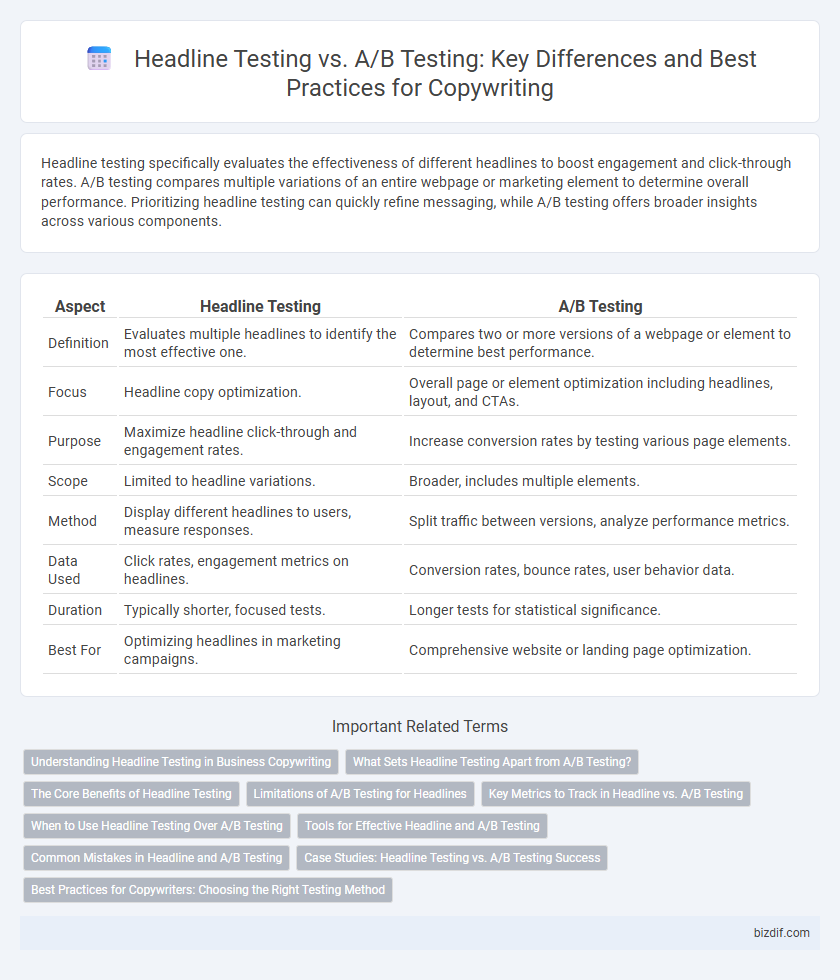Headline testing specifically evaluates the effectiveness of different headlines to boost engagement and click-through rates. A/B testing compares multiple variations of an entire webpage or marketing element to determine overall performance. Prioritizing headline testing can quickly refine messaging, while A/B testing offers broader insights across various components.
Table of Comparison
| Aspect | Headline Testing | A/B Testing |
|---|---|---|
| Definition | Evaluates multiple headlines to identify the most effective one. | Compares two or more versions of a webpage or element to determine best performance. |
| Focus | Headline copy optimization. | Overall page or element optimization including headlines, layout, and CTAs. |
| Purpose | Maximize headline click-through and engagement rates. | Increase conversion rates by testing various page elements. |
| Scope | Limited to headline variations. | Broader, includes multiple elements. |
| Method | Display different headlines to users, measure responses. | Split traffic between versions, analyze performance metrics. |
| Data Used | Click rates, engagement metrics on headlines. | Conversion rates, bounce rates, user behavior data. |
| Duration | Typically shorter, focused tests. | Longer tests for statistical significance. |
| Best For | Optimizing headlines in marketing campaigns. | Comprehensive website or landing page optimization. |
Understanding Headline Testing in Business Copywriting
Headline testing in business copywriting involves evaluating multiple headline variations to determine which one drives higher engagement and conversion rates. This targeted approach focuses specifically on optimizing headlines to capture audience attention, improve click-through rates, and enhance overall campaign performance. Unlike broad A/B testing, headline testing narrows the scope to one vital element, providing precise insights that refine messaging effectiveness.
What Sets Headline Testing Apart from A/B Testing?
Headline testing isolates headline variations to precisely measure their impact on click-through rates, while A/B testing compares broader changes across entire pages or campaigns. This focused approach enables marketers to optimize headlines for maximum engagement without interference from other variables. By concentrating solely on headline performance, headline testing delivers clearer insights into which phrases resonate best with target audiences.
The Core Benefits of Headline Testing
Headline testing targets the effectiveness of specific headlines to maximize engagement and click-through rates, providing precise insights into which wording resonates best with the audience. It allows marketers to quickly refine messaging by isolating headline variables, enhancing conversion rates without altering other page elements. This focused approach saves time and resources compared to broader A/B testing, making headline testing a strategic tool for optimizing content impact.
Limitations of A/B Testing for Headlines
A/B testing for headlines often faces limitations due to its focus on quantitative data, which may overlook subtle emotional or contextual factors influencing user engagement. The process requires significant traffic to achieve statistically significant results, making it less effective for smaller audiences or niche markets. Variability in audience segments and external factors can also skew A/B testing outcomes, leading to inconclusive or misleading insights for headline optimization.
Key Metrics to Track in Headline vs. A/B Testing
Headline testing focuses primarily on metrics such as click-through rates (CTR), engagement levels, and bounce rates to evaluate which headline drives more initial interest. A/B testing expands beyond headlines by also tracking conversion rates, time on page, and user behavior patterns to determine overall effectiveness of different page elements. Emphasizing relevant key performance indicators (KPIs) in each test ensures data-driven decisions that optimize marketing outcomes.
When to Use Headline Testing Over A/B Testing
Headline testing is ideal when the primary goal is to optimize click-through rates by evaluating multiple headline variations rapidly, especially in content marketing and email campaigns. It provides focused insights on the impact of wording, length, and emotional triggers in headlines without altering other webpage elements. Use headline testing over A/B testing when you need quick, headline-specific data to enhance audience engagement before implementing broader webpage or design changes.
Tools for Effective Headline and A/B Testing
Effective tools for headline testing include CoSchedule Headline Analyzer and Sharethrough Headline Analyzer, which optimize word balance and emotional impact to boost click-through rates. For A/B testing, platforms like Optimizely, VWO, and Google Optimize enable marketers to compare different headline variations by tracking user engagement metrics such as bounce rate and conversion rate. Integrating these tools streamlines the process of refining headlines based on real-time data, enhancing overall content performance and ROI.
Common Mistakes in Headline and A/B Testing
Common mistakes in headline testing include neglecting audience relevance and relying solely on click-through rates without considering conversion intent. In A/B testing, errors often involve insufficient sample size and failure to control external variables, leading to unreliable data. Both approaches require precise hypothesis formulation and continuous iteration to maximize copywriting effectiveness.
Case Studies: Headline Testing vs. A/B Testing Success
Case studies reveal that headline testing significantly boosts click-through rates by pinpointing the most compelling phrases, outperforming broader A/B testing which often dilutes focus across multiple variables. Marketing teams utilizing headline testing report up to a 30% increase in engagement, highlighting its precision in optimizing one key element. In comparison, A/B testing yields comprehensive insights but may extend timelines and dilute actionable results when assessing headline performance alone.
Best Practices for Copywriters: Choosing the Right Testing Method
Headline testing focuses specifically on optimizing headline effectiveness to increase click-through rates and engagement, while A/B testing compares multiple versions of an entire page or element for overall performance improvement. Copywriters should prioritize headline testing when the primary goal is to capture attention quickly, leveraging metrics like headline CTR and bounce rate. For broader conversion optimization involving multiple variables, A/B testing provides comprehensive insights into user behavior and overall content effectiveness.
Headline Testing vs A/B Testing Infographic

 bizdif.com
bizdif.com